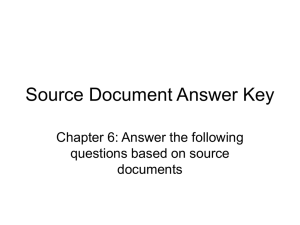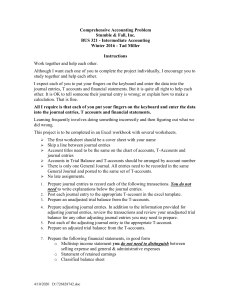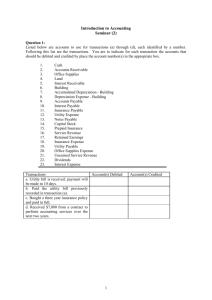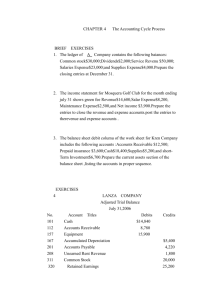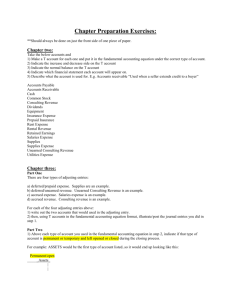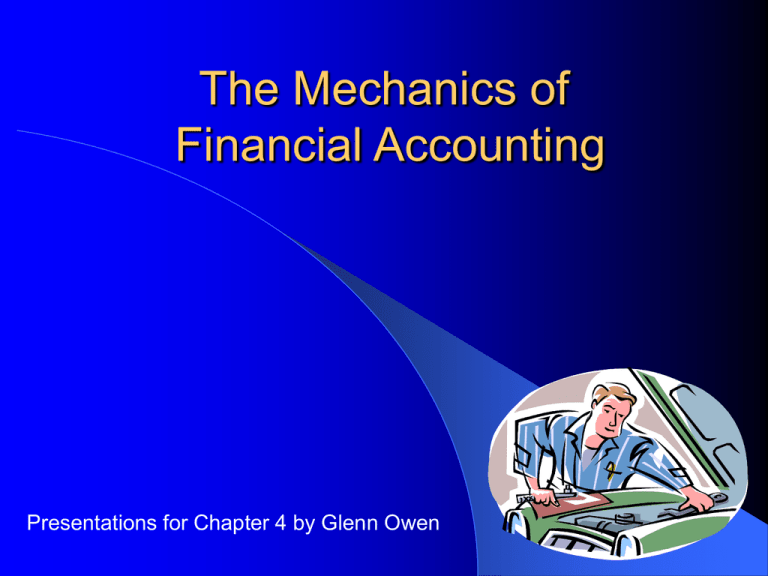
The Mechanics of
Financial Accounting
Presentations for Chapter 4 by Glenn Owen
Key Points
Two criteria necessary for economic events to be reflected in the
financial statements.
The accounting equation and how it relates to the balance sheet,
income statement, statement of retained earnings, and statement of
cash flows.
Journal entries (and T-accounts) and how they express the effect of
economic events on the basic accounting equation and the financial
statements.
Why managers need to understand how economic
events affect the financial statements.
Why the financial statements are adjusted
periodically to reflect certain economic events.
Economic Events
Relevant events have economic significance
to a company and include any occurrence
that affects its financial condition.
The dollar values assigned to these events
must be determined in an objective manner.
The Fundamental
Accounting Equation
Assets = Liabilities +
=
Stockholders’ Equity
+
The Journal Entry Box
1. What accounts are affected?
Assets
Asset Accounts
Increase
2. What is the direction
of the effect?
Liab/Stock Eq. Accounts
$Debit
(left)
$Credit
(right)
3. What is the dollar value
of the transaction?
Asset Accounts
Decrease
Liabilities and
= Stockholders’ Equity
$Credit
(right)
Liab/Stock Eq. Accounts
$Debit
(left)
Recognizing Gains
and Losses
Often investments and noncurrent assets are sold
for more or less than the amounts at which they
are carried on the balance sheet.
In such cases a gain or loss must be recognized.
Periodic Adjustments
Accruals
Deferrals and cost expirations
Revaluation adjustments
Accruals
The term accrue means to build up gradually.
Accruals refer to amounts in asset and liability
accounts that build up over time.
Adjustments to record accruals are made at the
end of an accounting period.
Examples include
– accrued wages.
– accrued interest revenue.
Deferrals and Cost Expirations
Deferrals are recorded to achieve an appropriate
matching of revenues and expenses and do not
reflect cash exchanges.
Expense or capitalize?
–
–
–
–
–
–
–
Current expenses
Supplies inventory
Merchandise inventory
Prepaid expenses
Unearned revenue
Property, plant, and equipment
Intangible assets
Expense or Capitalize
Incur cost in
current period
Decide what
period revenue is
generated
If current then expense, if
future, capitalize
Cost Expiration
Salaries
Current period
(expense)
Salary Exp XX
Salary Pay XX
None required
Interest
Current period
(expense)
Interest Exp XX
Interest Pay XX
None required
Receive Utility
Bill
Current period
(expense)
Utilities Exp XX
Accounts Pay XX
None required
Purchase
Supplies
Future period
(asset)
Supplies
Cash
Purchase
Inventory
Future period
(asset)
Inventory
XX
Accounts Pay XX
XX
XX
Supplies Exp XX
Supplies
XX
COGS
Inventory
XX
XX
Expense or Capitalize
Incur cost in
current period
Decide what
period revenue is
generated
If current then expense, if
future, capitalize
Prepaid Rent
Future period
(asset)
Prepaid Rent XX
Cash
XX
Rent Exp
XX
Prepaid Rent XX
Advance
Payments
Future period
(liability)
Cash
XX
Unearned Rev XX
Unearned Rev XX
Revenue
XX
Purchase
Equipment
Future period
(asset)
Equipment XX
Note Pay
XX
Depreciation XX
Acc. Dep.
XX
Purchase
Patent
Future period
(asset)
Patent
Cash
Amort. Exp XX
Acc. Amort. XX
XX
XX
Cost Expiration
Revaluation Adjustments
These are adjustments that do not fall into the
categories of accruals or cost expirations.
They serve to restate certain accounts to keep their
reported values in line with existing facts.
Examples include the revaluation of:
– short-term investments
– accounts receivable
– inventories
Review Problem
Kelly Supply
Beginning Balance Sheet as of December 31, 2002
Daily journal entries and T-accounts
Adjusting journal entries and T-accounts
Income Statement for the year ended December 31, 2003
Statement of Retained Earnings for the year ended
December 31, 2003
Ending Balance Sheet as of December 31, 2003
Statement of Cash Flows for the year ended December 31,
2003
Kelly Supply
Balance Sheet
December 31, 2002
Assets:
Cash
Accounts receivable
Merchandise inventory
Prepaid rent
Machinery
Less: Accumulated depreciation
Patent
Total assets
$12,000
15,000
12,000
3,000
$25,000
. 5,000
20,000
. 5,000
$67,000
Kelly Supply
Balance Sheet
December 31, 2002
Liabilities and Stockholders’ Equity:
Accounts payable
Wages payable
Interest payable
Dividends payable
Unearned revenue
Short-term notes payable
Long-term notes payable
Common stock
Retained earnings
Total liabilities and stockholders’ equity
$ 8,000
3,000
1,000
2,000
3,000
5,000
10,000
30,000
. 5,000
$67,000
Daily Journal Entries and T-accounts
(1) Cash (+A)
10,000
Accounts Receivable (+A)
15,000
Sales (R, +SE)
Sold merchandise for cash and on account.
Cash
12,00
0
10,00
0
Accounts Receivable
15,00
0
15,00
0
25,000
Sales
25,00
0
Daily Journal Entries and T-accounts
(2) Cash (+A)
Accounts Receivable (-A)
Received cash on account.
Cash
12,00
0
10,00
0
8,000
8,000
8,000
Accounts Receivable
15,00
0
15,00
0
8,000
Daily Journal Entries and T-accounts
(3) Merchandise Inventory (+A)
10,000
Cash (-A)
3,000
Accounts Payable (+L)
7,000
Purchased merchandise inventory for cash and on account.
Merchandise Inv.
12,00
0
10,00
0
Cash
12,00
0
10,00
0
8,000
Accounts Payable
3,000
8,000
7,000
Daily Journal Entries and T-accounts
(4) Accounts Payable (-L)
Cash (-A)
Paid cash on account.
Accounts Payable
10,00
0
8,000
7,000
10,000
10,000
Cash
12,00
0
10,00
0
8,000
3,000
10,00
0
Daily Journal Entries and T-accounts
(5) Wages Payable (-L)
Wages Expense (E, -SE)
Cash (-A)
Paid accrued wages.
Wages Payable
3,000
3,000
Wages Expense
7,000
3,000
7,000
10,000
Cash
12,00
0
10,00
0
8,000
3,000
10,00
0
10,00
0
Daily Journal Entries and T-accounts
(6) Interest Payable (-L)
Interest Expense (E, -SE)
Cash (-A)
Paid accrued interest.
Interest Payable
1,000
1,000
Interest Expense
1,000
1,000
1,000
2,000
Cash
12,00
0
10,00
0
8,000
3,000
10,00
0
10,00
0
2,000
Daily Journal Entries and T-accounts
(7) Short-Term Notes Payable (-L)
Cash (-A)
Paid short-term note.
S/T Notes Payable
5,000
2,500
2,500
2,500
Cash
12,00
0
10,00
0
8,000
3,000
10,00
0
10,00
0
2,000
2,500
Daily Journal Entries and T-accounts
(8) Cash (+A)
Long-Term Notes Payable (+L)
Issued long-term note for cash.
L/T Notes Payable
10,00
0
10,00
0
10,000
10,000
Cash
12,00
0
10,00
0
8,000
10,00
0
3,000
10,00
0
10,00
0
2,000
2,500
Daily Journal Entries and T-accounts
(9) Dividends Payable (-L)
Cash (-A)
Paid cash dividend.
Dividends Payable
2,000
2,000
2,000
2,000
Cash
12,00
0
10,00
0
8,000
10,00
0
3,000
10,00
0
10,00
0
2,000
2,500
2,000
Daily Journal Entries and T-accounts
(10)Machinery (+A)
Cash (-A)
Acquired machinery for cash.
Machinery
25,00
0
1,000
1,000
1,000
Cash
12,00
0
10,00
0
8,000
10,00
0
3,000
10,00
0
10,00
0
2,000
2,500
2,000
1,000
Daily Journal Entries and T-accounts
(11)Dividends (-SE)
Dividends Payable (+L)
Declared dividends.
Dividends
1,000
1,000
Dividends Payable
1,000
2,000
2,000
1,000
Adjusting Journal Entries and T-accounts
(12)Cost of Goods Sold (E, -SE)
9,000
Merchandise Inventory (-A)
Recognized $13,000 of inventory on hand.
Cost of Goods Sold
9,000
9,000
Merchandise Inventory
12,00
0
10,00
0
13,00
0
9,000
Adjusting Journal Entries and T-accounts
(13)Unearned Revenue (-L)
Sales (R, +SE)
Recognized 2/3 of goods delivered.
Unearned Revenue
3,000
2,000
1,000
2,000
2,000
Sales
25,00
0
2,000
Adjusting Journal Entries and T-accounts
(14)Interest Receivable (+A)
50
Interest Revenue (R,+SE)
Recognized accrued interest on savings account.
Interest Receivable
50
Interest Revenue
50
50
Adjusting Journal Entries and T-accounts
(15)Depreciation Expense (E, -SE)
3,000
Accumulated Depreciation (-A)
Recognized depreciation on machinery.
Depreciation Expense
3,000
Accumulated Depr.
5,000
3,000
3,000
Adjusting Journal Entries and T-accounts
(16)Amortization Expense (E, -SE)
Patent (-A)
Recognized amortization of patent.
Amortization Expense
500
500
500
Patent
5,000
500
4,500
Adjusting Journal Entries and T-accounts
(17)Wage Expense (E, -SE)
Wages Payable (+L)
Recognized accrued wages.
Wage Expense
7,000
1,000
1,000
1,000
Wages Payable
3,000
3,000
1,000
Adjusting Journal Entries and T-accounts
(18)Interest Expense (E, -SE)
2,000
Interest Payable (+L)
Recognized accrued interest on long-term note.
Interest Expense
1,000
2,000
Interest Payable
1,000
1,000
2,000
2,000
Adjusting Journal Entries and T-accounts
(19)Rent Expense (E, -SE)
1,000
Prepaid Rent (-A)
Recognized 1/3 of rent period expired.
Rent Expense
1,000
Prepaid Rent
3,000
1,000
2,000
1,000
Kelly Supply
Income Statement
For the Year Ended December 31, 2003
Revenues:
Sales
Interest revenue
Total revenues
Expenses:
Cost of goods sold
Wages expense
Rent expense
Interest expense
Depreciation expense
Amortization expense
Total expenses
Net income
$27,000
50
$27,050
$ 9,000
8,000
1,000
3,000
3,000
500
. 24,500
$ 2,550
Kelly Supply
Statement of Retained Earnings
For the Year Ended December 31, 2003
Beginning balance
Plus: Net income
Less: Dividends
Ending balance
$5,000
2,550
(1,000)
$6,550
Kelly Supply
Balance Sheet
December 31, 2003
Assets:
Cash
Accounts receivable
Interest receivable
Merchandise inventory
Prepaid rent
Machinery
Less: Accumulated depreciation
Patent
Total assets
$ 9,500
22,000
50
13,000
2,000
$26,000
8,000
18,000
4,500
$69,050
Kelly Supply
Balance Sheet
December 31, 2003
Liabilities and stockholders’ equity:
Accounts payable
Wages payable
Interest payable
Dividends payable
Unearned revenue
Short-term notes payable
Long-term notes payable
Common stock
Retained earnings
Total liabilities and stockholders’ equity
$ 5,000
1,000
2,000
1,000
1,000
2,500
20,000
30,000
6,550
$69,050
Kelly Supply
Statement of Cash Flows
For the Year Ended December 31, 2003
Operating activities:
Collections from sales
Collections of accounts receivable
Payment for inventory purchases
Payments on accounts payable
Payments for wages
Payments for interest
Net cash increase (decrease)
Investing activities:
Purchase of machinery
Net cash increase (decrease)
Financing activities:
Issuance of long-term notes payable
Payment of dividend
Payment of short-term notes payable
Net cash increase (decrease)
Net cash increase (decrease) during 2003
Beginning cash balance
Ending cash balance
$10,000
8,000
(3,000)
(10,000)
(10,000)
. (2,000)
$(7,000)
$(1,000)
(1,000)
$10,000
(2,000)
. (2,500)
. 5,500
$(2,500)
. 12,000
$ 9,500
COPYRIGHT
Copyright © 2003, John Wiley & Sons, Inc. All rights reserved.
Reproduction or translation of this work beyond that permitted in
Section 117 of the 1976 United States Copyright Act without the
express written permission of the copyright owner is unlawful.
Request for further information should be addressed to the
Permissions Department, John Wiley & Sons, Inc. The purchaser
may make back-up copies for his/her own use only and not for
distribution or resale. The Publisher assumes no responsibility
for errors, omissions, or damages, caused by the use of these
programs or from the use of the information contained herein.





